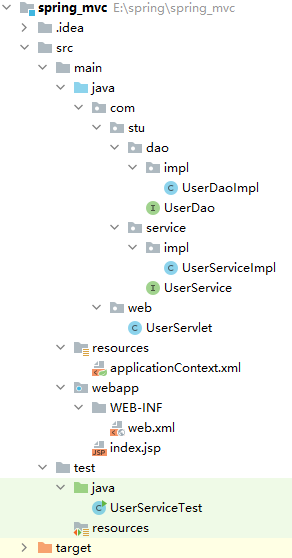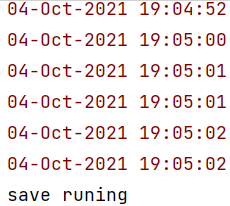步骤
①导入需要的坐标
代码示例
项目结构:

导入需要的坐标
<dependencies>
<dependency>
<groupId>org.springframework</groupId>
<artifactId>spring-context</artifactId>
<version>5.0.5.RELEASE</version>
</dependency>
<dependency>
<groupId>javax.servlet</groupId>
<artifactId>javax.servlet-api</artifactId>
<version>3.0.1</version>
<scope>provided</scope>
</dependency>
<dependency>
<groupId>javax.servlet.jsp</groupId>
<artifactId>javax.servlet.jsp-api</artifactId>
<version>2.2.1</version>
</dependency>
</dependencies>
新建接口UserDao.java:
package com.stu.dao;
/**
* @version:
* @author: 零乘一
* @description: userDao层
* @date: 2021/10/4 15:26
**/
public interface UserDao {
public void save();
}
新建实现类UserDaoImpl .java:
package com.stu.dao.impl;
import com.stu.dao.UserDao;
/**
* @version:
* @author: 零乘一
* @description: userDao实现层
* @date: 2021/10/4 15:27
**/
public class UserDaoImpl implements UserDao {
@Override
public void save() {
System.out.println("save runing");
}
}
新建接口类UserService.java:
package com.stu.service;
/**
* @version:
* @author: 零乘一
* @description: UserService层
* @date: 2021/10/4 15:32
**/
public interface UserService {
public void save();
}
新建实现类UserServiceImpl.java:
package com.stu.service.impl;
import com.stu.dao.UserDao;
import com.stu.service.UserService;
/**
* @version:
* @author: 零乘一
* @description: UserService实现层
* @date: 2021/10/4 15:32
**/
public class UserServiceImpl implements UserService {
private UserDao userDao;
public void setUserDao(UserDao userDao) {
this.userDao = userDao;
}
public void save(){
userDao.save();
}
}
新建配置文件ApplicationContext.xml:
<?xml version="1.0" encoding="UTF-8"?>
<beans xmlns="http://www.springframework.org/schema/beans"
xmlns:xsi="http://www.w3.org/2001/XMLSchema-instance"
xsi:schemaLocation="http://www.springframework.org/schema/beans http://www.springframework.org/schema/beans/spring-beans.xsd">
<bean id="userDao" class="com.stu.dao.impl.UserDaoImpl" />
<bean id="userService" class="com.stu.service.impl.UserServiceImpl">
<property name="userDao" ref="userDao"/>
</bean>
</beans>
新建类UserServlet.java:
package com.web;
import com.stu.service.UserService;
import com.stu.service.impl.UserServiceImpl;
import org.springframework.context.ApplicationContext;
import org.springframework.context.support.ClassPathXmlApplicationContext;
import javax.servlet.ServletException;
import javax.servlet.http.HttpServlet;
import javax.servlet.http.HttpServletRequest;
import javax.servlet.http.HttpServletResponse;
import java.io.IOException;
/**
* @version:
* @author: 零乘一
* @description: 类的简介
* @date: 2021/10/4 15:54
**/
public class UserServlet extends HttpServlet {
@Override
protected void doGet(HttpServletRequest req, HttpServletResponse resp) throws ServletException, IOException {
ApplicationContext applicationContext = new ClassPathXmlApplicationContext("applicationContext.xml");
UserService userService = applicationContext.getBean(UserService.class);
userService.save();
}
}
在web.xmnl中新增以下代码:
<servlet>
<servlet-name>UserServlet</servlet-name>
<servlet-class>com.web.UserServlet</servlet-class>
</servlet>
<!-- 映射-->
<servlet-mapping>
<servlet-name>UserServlet</servlet-name>
<url-pattern>/userServlet</url-pattern>
</servlet-mapping>

配置Tomcat



运行图片

运行tomcat后,在网址区域输入http://localhost:8080/userServlet在控制台打有以下结果就说明成功。

ApplicationContext应用上下文对象
概念
在Web项目中,可以使用ServletContextListener监听Web应用的启动,在Web应用启动时,就加载Spring的配置文件,创建应用上下文对象ApplicationContext,在将其存储到最大的域servletContext域中,这样就可以在任意位置从域中获得应用上下文ApplicationContext对象了。——黑马程序员
代码示例

新建类ContextLoaderListener.java:
package com.stu.listener;
import org.springframework.context.ApplicationContext;
import org.springframework.context.support.ClassPathXmlApplicationContext;
import javax.servlet.ServletContext;
import javax.servlet.ServletContextEvent;
import javax.servlet.ServletContextListener;
/**
* @version:
* @author: 零乘一
* @description: web启动监听器类
* @date: 2021/10/4 19:30
**/
public class ContextLoaderListener implements ServletContextListener {
@Override
public void contextInitialized(ServletContextEvent servletContextEvent) {
ApplicationContext applicationContext = new ClassPathXmlApplicationContext("applicationContext.xml");
//将Spring的应用上下文对象存储到Servlet域中
ServletContext servletContext = servletContextEvent.getServletContext();//获得ServletContext
servletContext.setAttribute("applicationContext",applicationContext);//通过ServletContext设置属性
System.out.println("spring容器创建完毕...");
}
@Override
public void contextDestroyed(ServletContextEvent servletContextEvent) {
}
}
类UserServlet.java新增以下代码:
// ApplicationContext applicationContext = new ClassPathXmlApplicationContext("applicationContext.xml");
// req.getServletContext();
ServletContext servletContext = this.getServletContext();
ApplicationContext applicationContext = (ApplicationContext) servletContext.getAttribute("applicationContext");

web.xml中新增以下代码:
<!-- 配置监听器-->
<listener>
<listener-class>com.stu.listener.ContextLoaderListener</listener-class>
</listener>

运行结果
在浏览器的网址中输入http://localhost:8080/userServlet

改进

这两处在代码中是已经写定了,耦合程度高,接下来进行解耦操作。
项目结构:

web.xml新增以下配置:
<!-- 全局初始化参数-->
<context-param>
<param-name>contextConfigLocation</param-name>
<param-value>applicationContext.xml</param-value>
</context-param>
报红没关系,不管它。
ContextLoaderListener.java的contextInitialized()方法内的代码更改为以下:
//将Spring的应用上下文对象存储到Servlet域中
ServletContext servletContext = servletContextEvent.getServletContext();//获得ServletContext
//读取web.xml中的全局参数
String contextConfigLocation = servletContext.getInitParameter("contextConfigLocation");
ApplicationContext applicationContext = new ClassPathXmlApplicationContext(contextConfigLocation);
servletContext.setAttribute("applicationContext",applicationContext);//通过ServletContext设置属性
System.out.println("spring容器创建完毕...");
新建类WebApplicationContextUtils:
package com.stu.listener;
import org.springframework.context.ApplicationContext;
import javax.servlet.ServletContext;
/**
* @version:
* @author: 零乘一
* @description: 类的简介
* @date: 2021/10/4 20:07
**/
public class WebApplicationContextUtils {
public static ApplicationContext getWebApplicationContext(ServletContext servletContext){
return (ApplicationContext) servletContext.getAttribute("applicationContext");
}
}
UserServlet.java新增以下代码:
// ApplicationContext applicationContext = (ApplicationContext) servletContext.getAttribute("applicationContext");
ServletContext servletContext = this.getServletContext();

这样写就不需要总是记住文件中指定的applicationContext的名,该方法会直接返回。
运行结果
在浏览器的网址中输入http://localhost:8080/userServlet

在控制台中打印出以下结果说明配置成功。
Spring提供获取应用上下文的工具
概念
上面的分析不用手动实现,Spring提供了一个监听器ContextLoaderListener就是对上述功能的封装,该监听器内部加载Spring配置文件,创建应用上下文对象,并存储到ServletContext域中,提供了一个客户端工具WebApplicationContextUtils供使用者获得应用上下文对象。——黑马程序员
步骤
①在web.xml中配置ContextLoaderListener监听器(导入spring-web坐标)
②使用WebApplicationContextUtils获得应用上下文对象ApplicationContext
在pom.xml新增以下坐标:
<dependency>
<groupId>org.springframework</groupId>
<artifactId>spring-web</artifactId>
<version>5.0.5.RELEASE</version>
</dependency>
web.xml新增以下配置:
<param-value>classpath:applicationContext.xml</param-value>
<listener-class>org.springframework.web.context.ContextLoaderListener</listener-class>

UserServlet的doGet方法替换为以下:
@Override
protected void doGet(HttpServletRequest req, HttpServletResponse resp) throws ServletException, IOException {
// ApplicationContext applicationContext = new ClassPathXmlApplicationContext("applicationContext.xml");
// req.getServletContext();
ServletContext servletContext = this.getServletContext();
// ApplicationContext applicationContext = (ApplicationContext) servletContext.getAttribute("applicationContext");
// ApplicationContext applicationContext = WebApplicationContextUtils.getWebApplicationContext(servletContext);
WebApplicationContext applicationContext = WebApplicationContextUtils.getWebApplicationContext(servletContext);
UserService userService = applicationContext.getBean(UserService.class);
userService.save();
}
运行结果
运行tomcat后,在网址区域输入http://localhost:8080/userServlet在控制台打有以下结果就说明成功。

Tomcat正常运行,且控制台有打印对应结果。





















 156
156











 被折叠的 条评论
为什么被折叠?
被折叠的 条评论
为什么被折叠?








